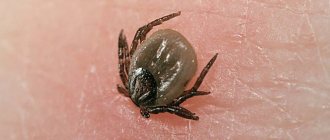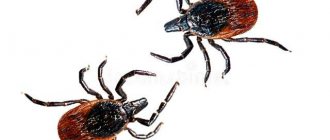Ticks pose a danger not only to humans, but also to our pets. The spring-summer period is the season when ticks are active; it is at this time that the likelihood of a tick bite is high. Of course, the problem of tick attacks is much more common among dog owners, since they usually spend more time outside. However, cats can also become victims of these dangerous parasites.
If your cat has free access to the outdoors, the likelihood of picking up a tick is high.
Externally, the ixodid tick looks like a small bug; it has an elongated body measuring about 3-4 mm, eight legs and a small head. The color of the parasite can vary from various shades of brown to gray and dark gray. Externally, the attached parasite looks like a gray or brown growth. The female's armored shield covers only a third of her body, allowing it to stretch when saturated. The size of a sucked ixodid tick grows to 1.5 - 3 cm.
To bite, the tick tries to choose inconspicuous places where it would be inconvenient for the animal to scratch it and places with soft skin, makes a small incision, digs into the skin, and begins to drink blood. The most popular bite points are:
- Withers area
- Stomach
- Groin
- Armpits
- Area behind the ears
Nature has endowed the tick with an ingenious device for piercing the skin and sucking blood - these are sharp, backward-facing teeth on the proboscis of the oral cavity. The oral apparatus is fixed very firmly; with a sudden movement, the head comes off. When a tick bites, it injects a special secretion that thins the blood and has an anesthetic effect. The secretion getting into the blood, damaging the integrity of the skin, causes a reaction of the immune system, which reacts with swelling, redness, and itching. Having eaten to its fill, the bloodsucker rests, and the female dies, having previously laid eggs.
Will a cat's tick fall off on its own?
Many people think that the most painless option, if a tick is already sitting on a cat, is to wait until it falls off on its own. In fact, it is in this situation that the risk of infection is maximum. As a rule, the parasite does not release infected saliva into the victim during the first 24 hours. In the next 24 hours, and especially before it falls off, it does this. This is why it is so important to remove the tick as early as possible.
How long a tick stays (sits) on a cat depends on its age and gender. Young nymphs and males only need a few hours (usually up to 6 hours) to drink blood. Adult females can sit for several days until they get so drunk that they increase in size several times. This is where the common misconception comes from: that males do not bite at all. They bite, but most often they are not even noticed. In this case, both males and even young nymphs can be infected and transmit the infection to the victim.
Ixodid ticks
The ixodid tick (ixodid) literally carries a bunch of infectious diseases. The most common are tick-borne encephalitis, Lyme borreliosis, typhus, Crimean-Congo hemorrhagic fever, tularemia, piroplasmosis and anaplasmosis of animals.
Fact! The range of infections depends on the region of residence and their prevalence.
They are not only carriers of various pathogens, but also their natural reservoirs, often lifelong. Horses, camels and livestock have long been the biological hosts for most tick species. This means that they are the same reservoirs for piroplasmids and other microaggressors as the aggressors themselves.
Be sure to read:
Where do fleas come from in a domestic cat, what is the danger and how to treat the animal?
At the same time, a person, subjected to constant attacks by ixodids, continues to be an accidental host for them. The bloodsucker manages to transmit the internal parasite into the human blood through infected saliva. Children are especially defenseless in this regard.
Among arthropods inhabiting wild nature, the following has been isolated:
- about 200 varieties of piroplasmids;
- more than 130 viruses;
- over three dozen rickettsiae;
- different types of spirochetes;
- bacteria are the causative agents of tularemia.
This list continues to grow. In terms of the total number of transmitted pathogens, ixodids are ahead of all groups of blood-sucking insects, including mosquitoes.
Salmonella, tularemia microbe, listeria, rickettsia remain active outside a living organism for a long time. Thus, relatives of spiders are not only carriers, but also dispersers of biopathogens in the environment.
Where to look for ticks on a cat?
Ticks are cunning creatures. They try to dig into a place where the cat itself cannot reach and where the bloodsucker most likely will not be noticed. The places where ticks bite cats are very diverse:
- on the neck;
- on the paw;
- on the body (body);
- on the tail;
- behind the ear;
- on the head;
- on the chin;
- between the paw pads;
- on the gums;
- on the mucous membrane of the eye.
Most often, the places where ticks dig into cats are invisible and hard to reach: neck, back, head, ear, armpits, stomach. Therefore, first of all, after a walk, to check your cat for ticks, look there.
If the parasite has just crawled under the cat's skin, it will look like a small black (brown) dot. Most often you can feel it with your fingers if you stroke the skin against the grain.
Signs of a tick bite
At first, the pet may look healthy, so it is so important to examine the animal after each walk to rule out a parasite bite.
The most common symptoms of infection include:
- general lethargy;
- lack of appetite;
- darkening of urine (this is one of the surest signs);
- inactivity;
- vomiting and diarrhea;
- strong thirst;
- high body temperature;
- pallor of the mucous membrane.
If you notice any of the above, seek help as soon as possible and take all necessary tests. Remember that even after treatment, the disease can relapse, so monitor your pet’s health.
The cat was bitten by a tick - what to do?
So, we found out how to detect a tick on a cat. Now let's talk about what to do if you find out that a parasite has attached itself to a cat. Your job is to safely remove the tick from your cat. There are two basic rules.
What a tick looks like on a cat depends on whether it has drunk blood or not.
Rule one. You cannot use pseudo-folk methods such as smearing with oil or alcohol, igniting with a hot match, etc. While the tick is suffocating and dying, it will release a lot of saliva under the skin: the risk of infection will increase. You should also not try to remove the bloodsucker using a syringe and vacuum. This method most often does not work, even if you retract the piston very hard. You can watch the video of a man trying to pull out a parasite with a syringe and not succeeding, after which he uses tweezers, but incorrectly, and therefore the body comes off, but the head remains inside.
Article continues after advertisement
Rule two. When you pull out a tick, grab it as close to the skin as possible, that is, do not grab it by the butt or the middle of the body. You need to grab it quite firmly, but gently. Compressing the head on both sides will block the salivary flow. At the same time, you should not grab so hard as to provoke the bloodsucker to release a portion of saliva into the blood, as well as to tear his body and leave his head in the skin.
4 Effective Extraction Methods
- Using thread. The tick must be wrapped in thread and tied as close to the base as possible. Next, twist the thread as shown in the video.
- Using a special tool. Such a tool has a slot into which the tick should fall, after which it is pulled up, twisting it around its axis.
- Using regular tweezers. This method is more difficult for beginners, but as a rule, the most ordinary tweezers are at hand. Its edges should not be sharp so as not to cut the tick. And they shouldn't be too thick, because... The tick must be squeezed, it must not slip out and cannot be crushed. Hold the tick with tweezers as close to the skin as possible, then begin to pull it out with even force perpendicular to the skin, while twisting the tweezers clockwise or counterclockwise.
- Using an acaricide or insectoacaricide (drops or spray against ticks). Spray the tick and wait about 1-2 hours for the poison to take effect. At this time, make sure that your pet does not lick the bite site. A dead tick may or may not fall off on its own. Then, already dead, you will still have to pull it out with tweezers or thread.
After the tick is removed, it must either be burned, flushed down the toilet, or placed in a hermetically sealed container on cotton wool moistened with water if you want to take the tick for analysis. You can also take it for analysis, but most veterinarians consider this a pointless exercise, because by the time the test results arrive, the animal will already show symptoms if the tick has infected it. In addition, the fact that a tick is infected does not guarantee that it has infected the pet.
Having hidden or killed the tick, the bite site must be treated with either a soap solution or a disinfectant (chlorhexidine, betadine, alcohol, etc.). Keep an eye on this area for several days and contact your veterinarian if there are any changes.
If you are very afraid of pulling out a tick yourself, it is better to also take the animal to the veterinarian.
You can purchase a special tick removal hook in advance so that you have one at home just in case.
This button will open the iHerb online store website. Using our link you will receive a 5% discount.
BUY
Routes of infection and risk factors
The seasons in which ticks pose the greatest danger are usually spring and early summer, when they wake up and actively reproduce. Tick bites on cats are quite common at these times of the year, so it is necessary to pay due attention to prevention (more on this below).
How can a tick get on your pet? In fact, he can climb onto it from any thing you are wearing: boots, trousers, outerwear, etc. As soon as you accidentally walk across the lawn and transfer the parasite home, the cat may already be bitten. Also, a cat and a tick may encounter a tick in an apartment if the parasite was brought by another animal that is often outdoors (for example, a dog).
Still, the risk of being bitten by pets is much lower than that of those who are allowed outside, so Murkosha strongly recommends keeping your pets at home. Otherwise, the risk of contracting infections through parasites and developing diseases of the skin and internal organs increases significantly.
Read more about the dangers of self-walking: Self-walking - when freedom means
What to do if the tick's head remains in the cat?
Sometimes it happens that the tick was pulled unsuccessfully, or the animal chewed out the parasite itself - and the head of the tick remained in the skin. This is a bad situation, but not fatal. Maybe, at the moment of pulling, he managed to release infected saliva into the victim, or maybe he didn’t have time. You won't know this for the time being. Now the task is different: to remove the head of the tick so that it does not cause an inflammatory and purulent process.
The head is a dead foreign element that the cat’s immune system will definitely reject. This will cause an inflammatory reaction, then the area will fester. After some time, the head along with the pus will come out from under the skin on its own. But it’s better not to let it come to that.
To remove the tick's head, use tweezers with pointed tips that are convenient for picking up small objects. But do not cut or pick at the bite site: if you cannot pull out the head, it is better to consult a doctor.
Symptoms of infection
If the dog owner has a picture of the disease and is familiar with the symptoms that characterize it, then emergency treatment can be started on time.
Symptoms may include:
- The earliest signs that should alert the owner are lethargy, a significant decrease in activity, loss of the dog’s inherent playfulness, failure to show joy, apathy, lack of desire to go for a walk, etc.;
- Lack of appetite, the dog only drinks, refusing even previously loved treats. Feeding the dog becomes a problem.
This is one of the main signs in the first days of infection; - Subsequently, on the third to fifth day, digestive symptoms become more alarming and obvious - vomiting appears, sometimes with mucus. At the same time, the dog has remained hungry for several days. Diarrhea is possible, the liquid masses of which have a bright yellow or greenish color. Symptoms of diarrhea are not necessary, but the color of the stool definitely changes;
- Stiffness of movement, reluctance to move, shortness of breath, as if every movement brings suffering. The dog tries to find a secluded place and not leave it. Such symptoms already indicate a progressive disease;
- The color of urine is a sign that necessarily accompanies the disease. The urine is much darker
, takes on the color of coffee or dark beer, sometimes even a dark brown color. Pyroplasmas in the blood destroy red blood cells, due to which the color of urine changes. This sign indicates irreversible processes that can lead to death; - Healthy dogs can tolerate the disease almost asymptomatically - the dog dies completely suddenly for its owners, without previously showing any special signs of illness. But the color of urine even in this case is unnatural, which owners should pay attention to;
- Fever;
- The mucous membranes of the eyes turn white.
A cat ate a tick - is it dangerous?
You should not allow your cat to bite ticks on his own, because... this increases the risk of infection and the risk of the head remaining in the skin.
Article continues after advertisement
The very fact of eating a tick, if the cat suddenly swallows it, poses little threat if the animal does not have wounds in the mouth and esophagus. But if they are present, an infection can enter the blood through these wounds from the tick along with saliva. Of course, this is only if the tick itself is infected and has also produced drool. The situation is unlikely, but it is better not to check.
Symptoms of a tick bite in cats
If you do not find a tick on a cat, but it falls off on its own, then the symptoms of the bite itself may not be noticed. The bite doesn't hurt, because... The tick releases an anesthetic substance under the skin. While eating, it may also not cause any discomfort. However, towards the end of the meal, discomfort and itching may occur. They can persist even after the tick falls off. That is, the consequences of a tick bite even without infection can manifest themselves in the form of redness, mild pain and suppuration if bacteria are introduced into the wound or the head of the parasite remains in it.
Some cats are allergic to mite saliva, ranging from mild redness and itching to severe pain, dizziness, fainting, and even anaphylactic shock. Such conditions must be corrected by a veterinarian.
But more often than not, the tick falls off unnoticed, and then lies in the apartment waiting for a new victim. This is the most dangerous situation, because... he can bite several family members at once. Bloodsuckers are able to wait a very long time for someone to turn up.
What does an ixodid tick look like?
And before or after meals? After all, these are two big differences!
Externally, the tick is similar to a spider - an oval body with a small head and eight limbs. They are quite large, and females are much larger than males. The body is covered with a dense chitinous shell. In the female, the armored shield occupies only the front part of the body, allowing their digestive system and integument to stretch from several mm to one and a half cm, depending on saturation. Therefore, ticks can feed rarely (sometimes once in a lifetime), but a lot.
Their oral apparatus is equipped with a proboscis with a hypostium - on the elongated outgrowth there are sharp, posteriorly directed teeth - this is a device for piercing the skin and sucking blood. During a bite, saliva is injected into the wound, containing pain-relieving enzymes and hardening around the proboscis like cement. Thus, the tick is firmly attached to the host and can sit on it for a long time, from 3-4 days to a month. The longer a tick sits, the more difficult it is to remove it (remember the expression “clung like a tick”).
The sucked parasite increases in size, acquiring a spherical shape. A hungry tick can be dark brown, black or brown; after eating, it turns red, pink or gray. The satiated parasite falls off to rest for digestion, the female lays eggs and dies.
In their development, ixodid ticks go through the following phases: egg, larva (six-legged), nymph and, finally, adult - adult (eight-legged). Larvae and nymphs usually live on small mammals (rodents), while adults live on large domestic animals.
Consequences of a bite and treatment
If a cat is bitten by an infected (encephalitis, etc.) tick, then the following symptoms are possible when infected:
- the cat is lethargic after a tick bite;
- suffers from poor appetite;
- the bite site turns red and a ring forms around it (a sign of Lyme disease);
- urine turns red or brown;
- the temperature has increased;
- and other.
These are all symptoms of infection. Even if you haven’t removed ticks from your cat in the near future, this does not mean that everything is in order. Be sure to show the animal to the veterinarian.
Prevention methods
Only by protecting your cat from ticks can you rest assured about its health..
Ticks do not bite cats when their fur and skin are treated with preparations with a contact, repellent effect. The death of the parasite occurs after a few minutes of being on the cat’s fur. The drugs are produced in the form of drops, collars, and sprays.
Effective means:
- Leopard;
- Hearts;
- Rolf Club;
- Bolfo;
- Frontline;
- Dana ultra;
- Beafar.
Anti-tick medications do not provide 100% confidence that arthropods will not attack your cat. But even if they cling to the wool, they will most likely fall off or die.
The cat was bitten by a tick - how to treat it?
If a cat, cat or small kitten is bitten by a tick, it does not mean that everything is lost. No treatment is required unless the bloodsucker is infected. According to statistics, only 25% of ticks are infected. But a bite from an infected tick does not always lead to infection. The earlier the owner noticed the parasite and removed it, the greater the chance of not getting an infection.
After the cat has caught a tick and it has been removed, it is necessary to monitor its condition and, in case of the slightest suspicion, contact a veterinarian. Be sure to warn the veterinarian about what happened the day before.
Many owners are interested in what to give their cat after a tick for prevention, that is, in case he does become infected. If there are no symptoms of illness, there is no need to give anything: the treatment itself is quite toxic, so there is no point in feeding the animal with medications every time the parasite is removed from it. You shouldn’t give interferons, which veterinarians sometimes recommend “just in case.”
Organizing independent treatment in case of symptoms is strictly prohibited. Only a veterinarian can make a correct diagnosis: many symptoms are the same for different diseases, so tests are needed. And self-treatment will only cause harm.
Article continues after advertisement
Treatment of tick-borne infections
By the way, not every suction ends in infection and illness.
The success of transmitting an infectious dose sufficient to cause infection depends on a number of factors:
- on the species characteristics of the pathogen;
- successful completion of the nutrition cycle;
- susceptibility of the victim's body.
But this does not mean that tick bites should be taken lightly. Since the complications occur in an extremely severe form, it is very important to stop the development of the disease in time.
Treatment methods depend on the type of pathogen that the cat is infected with. These can be antiparasitic agents, antibiotics. The regimen is selected individually for each animal and is additionally combined with vitamin therapy, hepatoprotectors and anti-inflammatory drugs.
How to keep your pet safe?
Check the coat after every walk. The simplest thing is to prevent the bite itself, because the tick crawls on the victim for quite a long time before biting. Along with the inspection, it is also better to comb the fur with a fine-toothed comb so that the tick remains on it if it is still crawling.
And don’t forget that you can only walk outside with protection: a collar, drops or spray against ticks and fleas. If your cat brings ticks home despite the presence of protection, change the product to a more effective one.
Rate and share!










